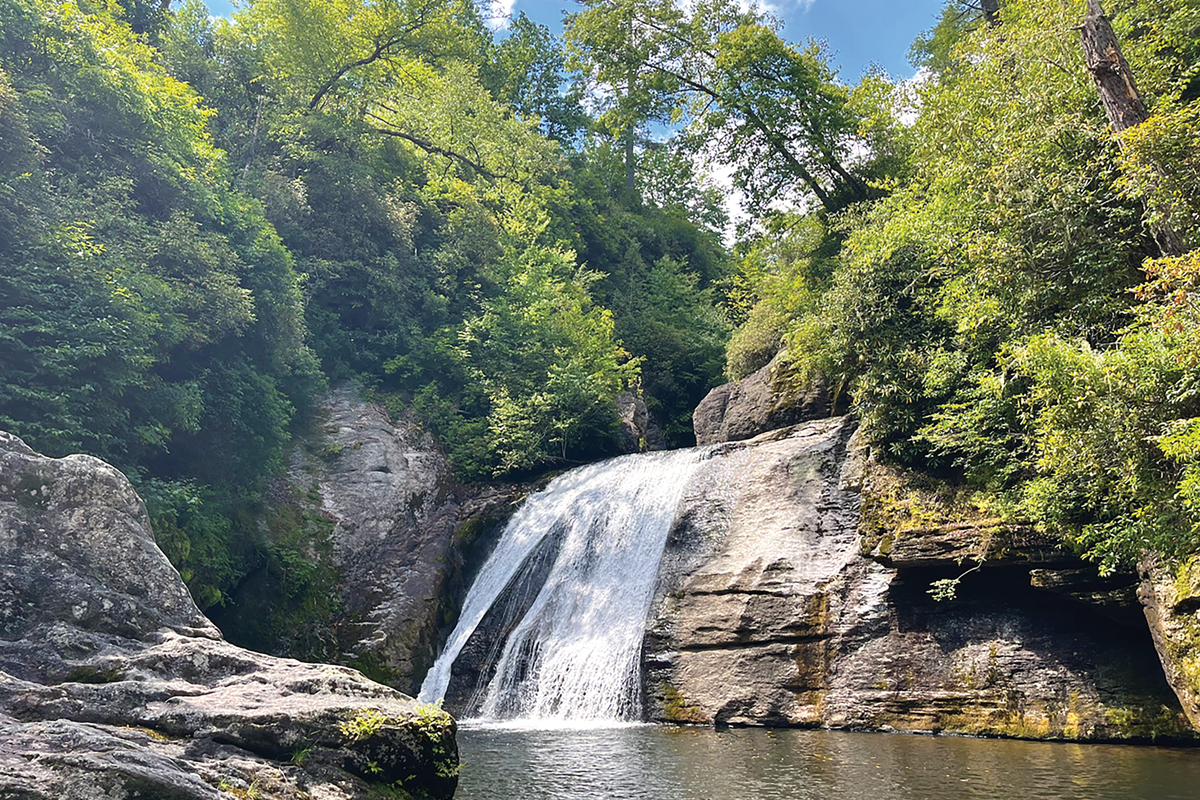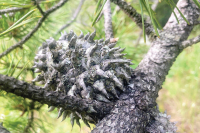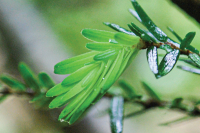Conservation groups file suit over Plateau timber project
 The Whitewater River, which borders the area proposed for logging, has been recommended for scenic designation under the National Wild and Scenic Rivers Act. Will Harlan/Center for Biological Diversity photo
The Whitewater River, which borders the area proposed for logging, has been recommended for scenic designation under the National Wild and Scenic Rivers Act. Will Harlan/Center for Biological Diversity photo
In a newly filed lawsuit, a coalition of conservation organizations is alleging that a controversial U.S. Forest Service logging project on the Cashiers-Highlands Plateau violates federal law.
“The Southside Project is a case study of the Forest Service’s reckless resolve to push harmful logging onto exceptional landscapes,” said Nicole Hayler, director of the Chattooga Conservancy, one of the plaintiffs in the case. “Logging in this area along the Whitewater River is a prime example of the root of the problem: deeply flawed, perverse incentives driving the Forest Service to hit mandated timber targets, which is why the entire Southside Project should be dropped.”
The Center for Biological Diversity, Defenders of Wildlife, MountainTrue and Sierra Club are also plaintiffs on the lawsuit, represented by the Southern Environmental Law Center, with the U.S. Forest Service and Nantahala District Ranger Troy Waskey, in his official capacity, named as defendants. The suit was filed Jan. 31 in the U.S. District Court of Western North Carolina. Hayler would like to see the entire Southside Project thrown out, but the lawsuit focuses on 15 acres within the 317-acre project.
“This particular stand, there was a real basic legal purchase in the new forest plan to challenge it,” she said.
The plaintiffs want the court to stop logging on that stand, order the Forest Service to compensate them for the cost of their legal process and enter a declaratory judgement that logging the stand “is inconsistent with the 2023 Forest Plan, violates that National Forest Management Act, and that Defendants have a mandatory duty to update its ongoing projects to be consistent with the 2023 Forest Plan.”
Exceptional ecology
First proposed in 2017, the Southside Project garnered stiff opposition from day one.
Related Items
The project aims to use timber harvest to create 317 acres of young forest spread across 23 separate stands in a 19,000-acre project area, with the goal of improving wildlife habitat, species diversity, soil and water resources and forest health. Young forest is important habitat for many wildlife species, and it’s in short supply on the Pisgah-Nantahala National Forest. But the Southside Project area isn’t the place to create such habitat, opponents say, claiming that many of the stands slated for harvest contain old-growth forest, rare species and other special values that would be destroyed by the proposed logging.
Nevertheless, the Forest Service made its final decision in 2019 and awarded the first logging bid in 2022 after an initial bidding process in 2021 failed to garner any responses. The second time around, the agency received a bid for $55,600 to log 98 acres, including 37 acres along and atop Brushy Mountain. Many of the same conservation organizations involved in the new lawsuit fought to protect those tracts from logging, saying they contained exceptional old growth and vital habitat for the rare green salamander. However, their efforts were not successful.

The Southside Project would include harvesting 317 acres within a 19,000-acre project area in Jackson and Macon counties. USFS map
Now, the organizations are disputing logging plans for a 15-acre stand along the Whitewater River, which is located on the Jackson-Transylvania county line about 5 miles southeast of Cashiers.
“The landscape boasts stunning waterfalls, towering oak trees, and critical habitat for rare species,” reads a press release from SELC. “Both the Forest Service and State of North Carolina have recognized the area slated for logging as an exceptional ecological community with some of the highest biodiversity values in the state.”
That recognition is at the heart of the organizations’ legal argument against the plan. Last year, the Forest Service approved the first new management plan for the Pisgah and Nantahala national forests since 1987. The plan recommended the stretch of the Whitewater River bordering the 15-acre stand for congressional designation as a scenic river under the National Wild and Scenic Rivers Act, and it placed the stand itself in a management area called a Special Interest Area, a classification for “the most exceptional ecological communities that serve as core areas for conservation of the most significant and rare elements of biological diversity on the Forests.” Though maintenance activities may be needed to maintain their ecological integrity, these areas are “generally resilient and are not in need of active restoration,” the forest plan states.
Forest Service policy requires that rivers deemed eligible for National Wild and Scenic River designation be managed in a way that won’t disqualify them from ongoing eligibility. To protect these segments, the 2023 forest plan establishes a quarter-mile corridor from each riverbank where any forestry activities must be “carried out in such a way that there is no substantial adverse effect on the river and its immediate environment.” Similarly, the plan allows logging on land within a Special Interest Area management area for only a narrow set of reasons. These include improving habitat for imperiled species, benefiting rare plant communities, supporting historic fire regimes, providing for public safety and reducing hazards from insects and diseases.
The plaintiffs claim that the Southside plan does not comply with these parameters.
“When the new forest plan identifies these rivers as eligible, the Forest Service is supposed to take measures to preserve its eligibility,” Hayler said. “Well, this does not qualify. This timber prescription, which is the nuts and bolts of what trees are actually going to be cut, did not meet the guidelines for Special Interest Areas or how you’re supposed to treat eligible Wild and Scenic River corridors.”
Compliance with new forest plan disputed
The Southside Project was approved years before the new forest plan was finalized, but the federal National Forest Management Act requires that the Forest Service review projects that bridge the divide between old and new forest plans to ensure they comply with the new plan. According to the lawsuit, the conservation groups “repeatedly” told the Forest Service that logging the Whitewater River stand wasn’t consistent with the new forest plan — but the agency disagreed.
“I have not identified the need to modify any pre-existing actions involving permits, contracts, or other instruments for the use and occupancy of National Forest System lands due to inconsistencies with the revised plan,” Forest Supervisor James Melonas wrote in the record of decision for the 2023 forest plan. “These actions will be implemented according to the terms of the applicable instrument. However, should the need arise, I have the discretion to modify these permits, contracts or other instruments for the use and occupancy of National Forest System land.”

An old tree towers within the project area. Will Harlan/Center for Biological Diversity photo
Even before the new forest plan was in place, with its recommendation for Wild and Scenic River status and placement of the stand in a protective management area, the Whitewater River stand fell within a state-designated Natural Heritage Natural Area. More than 2,400 such areas have been identified statewide, qualifying as having “special biodiversity significance due to the presence of rare species, unique natural communities, important animal assemblages or other ecological features,” according to the program website. The Forest Service directly addressed public concern about the stand’s future in the “Response to Comments” section of its draft Environmental Assessment for the Southside Project, released in July 2018. It wrote that the stand was, in many areas, dominated by white pine as an “artifact of previous land use history,” and that in its natural state a montane-oak hickory forest type would cover the area.
“It would be beneficial to remove the white pines from this stand, and then manage the area after harvest in such a way to restore the natural community that would naturally be found here,” the response reads. “This could be attained through prescribed fire, supplemental planting, or a mixture of the two.”
The response went on to say that white pine was largely absent from slopes within 150 feet of the Whitewater River, and so, “if possible,” timber harvest in these areas “should be avoided,” as the forest there is of high quality.
“Ideally, timber harvest activities in this stand would be restricted to white pine,” the response reads.
The final decision for the Southside project does not mandate that harvest be limited to white pine, however. It merely states that harvest on the Whitewater River stand will use the two-age method, in which most trees are cut to regenerate a new stand while leaving a sparse overstory of older trees. Additionally, a temporary 0.18-mile access road would be built to facilitate logging. Trees that contain dens or produce hard nuts would be prioritized as leave trees, so while white pines would be unlikely to be chosen as leave trees, nothing in the plan prevents other types of trees from being included among those to be logged.
The decision does contain one noteworthy stipulation for the stand: if the Whitewater River is found eligible for inclusion in the National Wild and Scenic Rivers System, any logging on the stand along it “shall maintain the outstandingly remarkable values and free-flowing nature of the river.” The forest plan determined that the river was eligible for inclusion, with congressional action required to officially designate it.
Irons in the fire
The Southside Project is not the groups’ only argument with the Forest Service. In August, SELC represented a similar cadre of conservation groups — minus the Chattooga Conservancy, plus The Wilderness Society — in declaring its intent to sue the Forest Service over alleged violations of the Endangered Species Act in the new forest plan. If the Forest Service didn’t address the issues raised within 60 days, the groups said, they would file suit.
Sixty days has come and gone, but that doesn’t mean a lawsuit is off the table, said SELC spokesperson Eric Hilt.
“We’re still evaluating the most effective path for the ESA litigation but have not filed yet,” Hilt said. “We wanted to take a look at this really urgent need [with the Southside Project].”
The Forest Service declined an opportunity to comment on the Southside Project lawsuit. The agency has 60 days from the summons date of Feb. 1 to submit an answer to the complaint or a motion in response to it.













